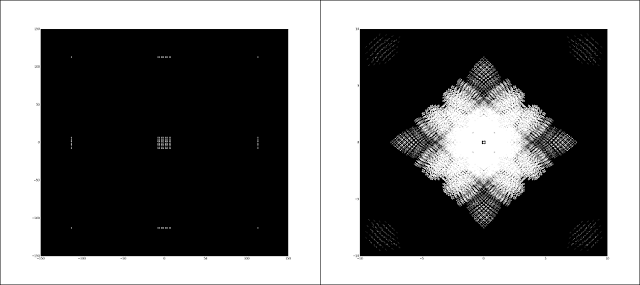The last months of 2015 I have been trying to get more expressions similar to the ones I found in my previous post "About Fortunate numbers and other similar expressions". So this is a follow-up note with some interesting results. This post is also a mirror of the question I did at MSE (click here).
The generalized idea is finding an expression E(n), whose distances between the value of the expression and the next prime closer to the expression, N(E(n)), and from the expression to the previous closer prime, P(E(n)), are both prime numbers or 1.
I tried several combinations, but the following one seems to work
properly so far and is not related with factorials or primorials, so I
believe it would be easier to test:
"Record values" are defined as the subset of values sigma_1(m) of the set of sum of divisors of a natural number m who are bigger than any previous values of the set, up to that value m, so it provides a strictly increasing set of values of sigma_1(m). Those are exactly the values of OEIS A034885: (1,3,4,7,12,15,18,28,31,39,42... )
These are the first elements of the set E(n)E(n), associated to their respective values of OEIS A034885 (= "m's whose sigma_1(m) is part of the sequence OEIS A034885"). They are the Highly Abundant Numbers (OEIS A002093):
{1,2,3,4,6,8,10,12,16,18,20,24,30,36,42,48...}
The point is that tested up to 10^27 both the distances of those elements E(n)E(n) to the previous and following closer primes (when there is a previous positive prime) is also a prime number or 1.
Here is the PARI/GP code to test up to 10^9:
testlimit = 10^9;n=1;exitval=0;prevsumdiv=0;while((n<testlimit) && (exitval==0),dj=divisors(n);sum_div=0;for(t=1,length(dj),sum_div=sum_div+dj[t]);while(sum_div<=prevsumdiv,sum_div=0;n=n+1;dj=divisors(n);for(t=1,length(dj),sum_div=sum_div+dj[t]));prevsumdiv = sum_div;np=nextprime(n+1);npmn=np-n;pp=precprime(n-1);nmpp=n-pp;if((nmpp==1 || isprime(nmpp)) && (npmn==1 || isprime(npmn)), print("n= ",n," sigma1(n)= ",sum_div," N(n)= ",np," N(n)-n= ", npmn ," P(n)= ",pp," n-P(n)= ", nmpp);,exitval=1;));
The big question is.. why does it happen? as far as I can see, it does not happen for other values of sigma_1(m), only for the m's behind the record values of sigma_1(m) as explained above. I can not imagine which possible reason is behind that property. I wonder if there are similar expressions based on other non-factorial functions. So far I have tried using the totient function and some sums of divisors of even numbers instead of sigma_1(n), all of them unsuccessfully. I did not find any reference to this possible conjecture yet.
Update 2015/12/24: I have been able to reduce the expression. It is possible to use instead of sigma_1(m) a reduced version of the sum of divisors, I will call it sigma_e(m) defined as the sum of the even composite divisors of m not including m itself in case of being even. In other words, it is the sum of divisors not including the sum of the prime numbers that are divisors, odd divisors, 1 and m itself. E(n) is:
So it is not required to use A034885 anymore. Apart from this expression, I tried also using the sum of the prime divisors of m, and other combinations of partial sums of the divisors of m, including 1 and m itself, but those ones did not work. The even divisors seem to be the key.
This is an example including the interval [1,99].
Update 2016/01/04: I was able to test it for the Highly Abundant Numbers up to 10^27. No counterexamples found.
Update 2016/01/05: Amazingly ∀h∈ {Highly Abundant Numbers}, h>3,tested up to 10^27 no counterexamples found, the closest prime number p<h located to a distance d=(h−p)>1 is also always at a prime distance, so d∈P. If the test is not wrong, these would mean that the even Highly Abundant Numbers greater than 2 have always at least a Goldbach pair of primes. h=p+d,p,d∈P.
Update 2016/01/06: Regarding the Highly Abundant Numbers conjecture I found a similar question from some years ago at MSE here so this idea is not new. The good point of my version is that I was able to avoid the use of the HAN replacing them by the records of the sum of the even non-prime divisors. I have made further tests and it is possible to do the same with the records of the sum of the non-prime multiples of 3 divisors, the distance between the numbers is bigger but the property seems to hold as well.
Update 2016/01/06: Regarding the Highly Abundant Numbers conjecture I found a similar question from some years ago at MSE here so this idea is not new. The good point of my version is that I was able to avoid the use of the HAN replacing them by the records of the sum of the even non-prime divisors. I have made further tests and it is possible to do the same with the records of the sum of the non-prime multiples of 3 divisors, the distance between the numbers is bigger but the property seems to hold as well.














































